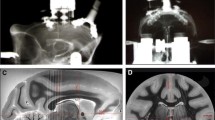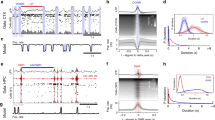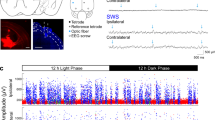Summary
Spontaneous firing of midbrain reticular formation (MRF) neurons was recorded extracellularly in chronically implanted, behaving cats during steady and transitional states of the sleep-waking cycle. Physiological identification of receiver and/or projection MRF neurons was achieved through orthodromically and antidromically elicited discharges.
Discharge rates of MRF neurons were more than double in waking (W) and active sleep (D) without phasic motor events, as compared to synchronized sleep (S). During behavioral states associated with EEG activation, the increased firing was essentially due to cells exhibiting high discharge rates, located at relatively ventral levels of the midbrain core. MRF neurons with identified rostrally projecting axons were more active during W and D states; their discharge rates were significantly higher than those of caudally projecting cells. The discharge patterns of MRF neurons increasing their firing rates from S to W and D were of the tonic type. First-order analyses showed a negligible proportion of both very short and long interspike intervals in all states, large interval density around the mode especially in W and D, and the smallest variation coefficients in W. Rhythmic firing with a period near the modal interval was detected during W by autocorrelations.
The increase in firing rate of MRF neurons from S to W or D took place before overt EEG desynchronization and behavioral manifestations that define stable W or D states. In our sample a statistically significant increase in discharge rate was found about 15 s before the end of S sleep epochs that developed into awakening.
The differences between discharge features of MRF neurons during waking and sleep states and those of neurons in other brainstem reticular fields are emphasized. Taken together, these data support, at a cellular level, Moruzzi and Magoun's concept of a rostral reticular substrate that gives rise to impulses leading to tonic activation of the thalamocortical systems.
Similar content being viewed by others
References
Berman AL (1968) The brain stem of the cat. University of Wisconsin Press, Madison.
Edwards SB, De Olmos JS (1976) Autoradiographic studies of the projections of the midbrain reticular formation. Ascending projections of nucleus cuneiformis. J Comp Neurol 165: 417–432.
Hartse KM, Eisenhart SF, Bergmann BM, Rechtschaffen A (1979) Ventral hippocampus spikes during sleep, wakefulness and arousal in the cat. Sleep 1: 231–246.
Hobson JA, McCarley RW, Freedman R, Pivik RT (1974a) Time course of discharge rate changes by cat pontine brainstem neurons during sleep cycle. J Neurophysiol 37: 1297–1309.
Hobson JA, McCarley RW, Pivik RT, Freedman R (1974b) Selective firing by cat pontine brainstem neurons in desynchronized sleep. J Neurophysiol 37: 497–511.
Huttenlocher PR (1961) Evoked and spontaneous activity in single units of medial brain stem during natural sleep and waking. J Neurophysiol 24: 451–468.
Jouvet M (1972) The role of monoamines and acetylcholine-containing neurons in the regulation of the sleep-waking cycle. Ergeb Physiol 64: 166–307.
Kanamori N, Sakai K, Jouvet M (1980) Neuronal activity specific to paradoxical sleep in the ventromedial medullary reticular formation of unrestrained cats. Brain Res 189: 251–255.
Kasamatsu T (1970) Maintained and evoked unit activity in the mesencephalic reticular formation of the freely behaving cat. Exp Neurol 28: 450–470.
Krnjevic K (1974) Chemical nature of synaptic transmission in vertebrates. Physiol Rev 54: 418–540.
Lamarre Y, Filion M, Cordeau JP (1971) Neuronal discharge of the ventrolateral nucleus of the thalamus during sleep and wakefulness in the cat. I. Spontaneous activity. Exp Brain Res 12: 480–498.
Manohar S, Noda H, Adey WR (1972) Behavior of mesencephalic reticular neurons in sleep and wakefulness. Exp Neurol 34: 140–157.
McCarley RW, Hobson JA (1975) Discharge patterns of cat pontine brain stem neurons during desynchronized sleep. J Neurophysiol 38: 751–766.
Moruzzi G (1972) The sleep-waking cycle. Ergeb Physiol 64: 1–165.
Moruzzi G, Magoun HW (1949) Brain stem reticular formation and activation of the EEG. Electroencephalogr Clin Neurophysiol 1: 455–473.
Oakson G (1981) A data acquisition and transfer system for analysis of neuronal activity by a central computer. IEEE Trans Biomed Eng BME-28: 299–301.
Oakson G, Steriade M (1982) Slow rhythmic rate fluctuations of cat midbrain reticular neurons in synchronized sleep and waking, (subm. for public.).
Purpura DP (1970) Operations and processes in thalamic and synaptically related neural subsystems. In: Schmitt FO (ed) The neurosciences, second study program. The Rockefeller University Press, New York, pp 458–470.
Ropert N, Steriade M (1981) Studies on input-output organization of the midbrain reticular core. J Neurophysiol 46: 17–31.
Sakai K, Sastre JP, Kanamori N, Jouvet M (1981) State specific neurons in the ponto-medullary reticular formation with special reference to the postural atonia during paradoxical sleep in the cat. In: Pompeiano O, Ajmone-Marsan C (eds) Brain mechanisms and perceptual awareness. Raven Press, New Yor, pp 405–429.
Segundo JP, Perkel DH, Wyman H, Hegstad H, Moore G (1968) Input-output relations in computer-simulated nerve cells. Kybernetic 4: 157–171.
Siegel JM, McGinty DG, Breedlove SM (1977) Sleep and waking activity of pontine giganto cellular field neurons. Exp Neurol 56: 553–573.
Singer W (1977) Control of thalamic transmission by corticofugal and ascending reticular pathways in the visual system. Physiol Rev 57: 386–420.
Steriade M (1978) Cortical long-axoned cells and putative interneurons during the sleep-waking cycle. Behav Brain Sci 1: 465–485, 511–514.
Steriade M (1980) State-dependent changes in the activity of rostral reticular and thalamocortical elements. In: Hobson JA, Scheibel A (eds) The brainstem core: Sensorimotor integration and behavioral state control. MIT Press, Cambridge, pp 83–91.
Steriade M (1981) Mechanisms underlying cortical activation. Neuronal organization and properties of the midbrain reticular core and intralaminar thalamic nuclei. In: Pompeiano O, Ajmone-Marsan C (eds) Brain mechanisms and perceptual awareness. Raven Press, New York, pp 327–377.
Steriade M, Hobson JA (1976) Neuronal activity during the sleepwaking cycle. Prog Neurobiol 6: 155–376.
Steriade M, Iosif G, Apostol V (1969) Responsiveness of thalamic and motor relays during arousal and various stages of sleep. J Neurophysiol 32: 251–265.
Steriade M, Oakson G, Kitsikis A (1978) Firing rates and patterns of output and nonoutput cells in cortical areas 5 and 7 of cat during the sleep-waking cycle. Exp Neurol 60: 443–468.
Steriade M, Ropert N, Kitsikis A, Oakson G (1980) Ascending activating neuronal networks in midbrain reticular core and related rostral systems. In: Hobson JA, Brazier MAB (eds) The reticular formation revisited. Raven Press, New York, pp 125–167.
Vertes RP (1979) Brain stem gigantocellular neurons. Patterns of activity during behavior and sleep in the freely moving rat. J Neurophysiol 42: 214–228.
Author information
Authors and Affiliations
Additional information
Supported by grant MT-3689 from the Medical Research Council of Canada
Part of the results was incorporated in the Ph. D. thesis of N. Ropert
Rights and permissions
About this article
Cite this article
Steriade, M., Oakson, G. & Ropert, N. Firing rates and patterns of midbrain reticular neurons during steady and transitional states of the sleep-waking cycle. Exp Brain Res 46, 37–51 (1982). https://doi.org/10.1007/BF00238096
Received:
Published:
Issue Date:
DOI: https://doi.org/10.1007/BF00238096




